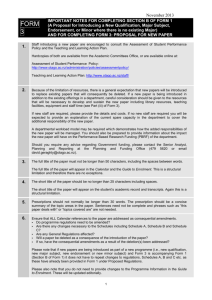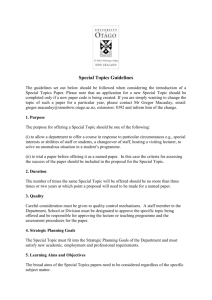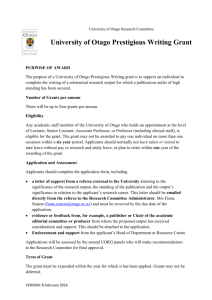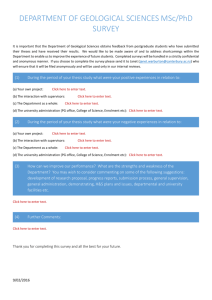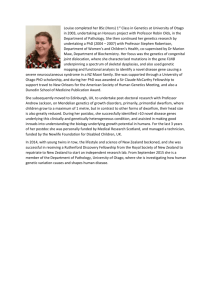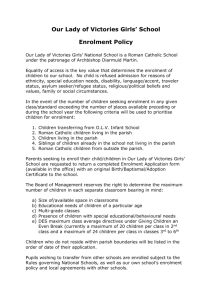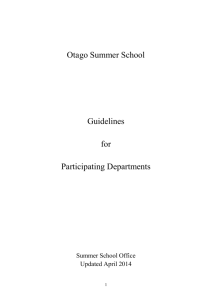Form 3 Proposal for a new paper
advertisement
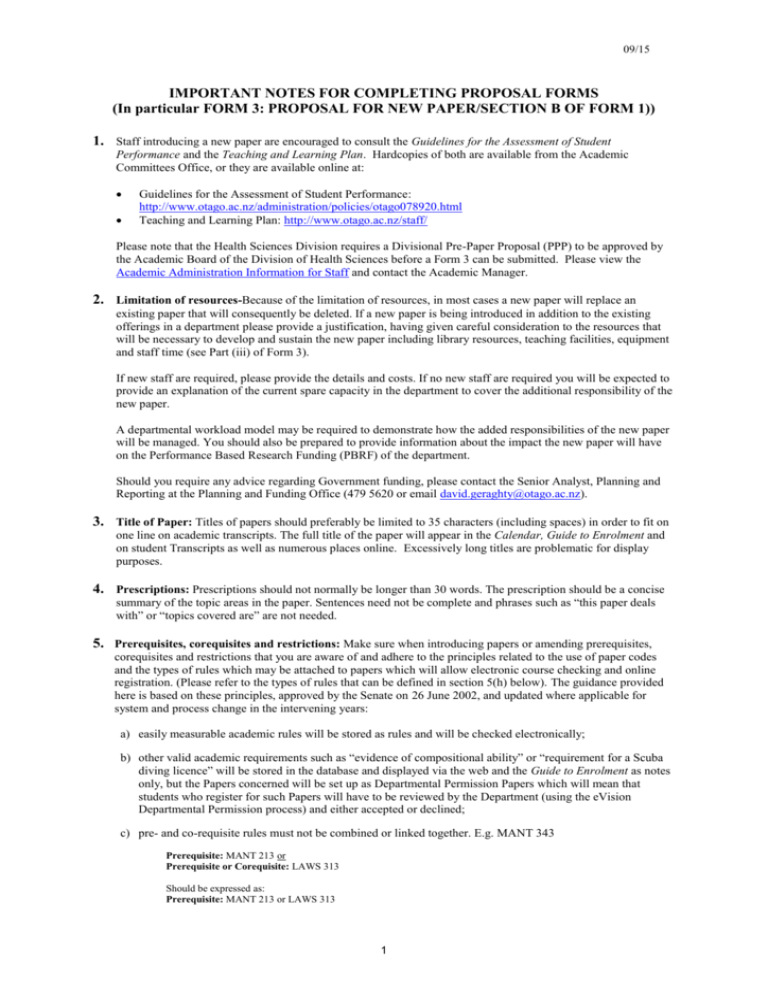
09/15 IMPORTANT NOTES FOR COMPLETING PROPOSAL FORMS (In particular FORM 3: PROPOSAL FOR NEW PAPER/SECTION B OF FORM 1)) 1. Staff introducing a new paper are encouraged to consult the Guidelines for the Assessment of Student Performance and the Teaching and Learning Plan. Hardcopies of both are available from the Academic Committees Office, or they are available online at: Guidelines for the Assessment of Student Performance: http://www.otago.ac.nz/administration/policies/otago078920.html Teaching and Learning Plan: http://www.otago.ac.nz/staff/ Please note that the Health Sciences Division requires a Divisional Pre-Paper Proposal (PPP) to be approved by the Academic Board of the Division of Health Sciences before a Form 3 can be submitted. Please view the Academic Administration Information for Staff and contact the Academic Manager. 2. Limitation of resources-Because of the limitation of resources, in most cases a new paper will replace an existing paper that will consequently be deleted. If a new paper is being introduced in addition to the existing offerings in a department please provide a justification, having given careful consideration to the resources that will be necessary to develop and sustain the new paper including library resources, teaching facilities, equipment and staff time (see Part (iii) of Form 3). If new staff are required, please provide the details and costs. If no new staff are required you will be expected to provide an explanation of the current spare capacity in the department to cover the additional responsibility of the new paper. A departmental workload model may be required to demonstrate how the added responsibilities of the new paper will be managed. You should also be prepared to provide information about the impact the new paper will have on the Performance Based Research Funding (PBRF) of the department. Should you require any advice regarding Government funding, please contact the Senior Analyst, Planning and Reporting at the Planning and Funding Office (479 5620 or email david.geraghty@otago.ac.nz). 3. Title of Paper: Titles of papers should preferably be limited to 35 characters (including spaces) in order to fit on one line on academic transcripts. The full title of the paper will appear in the Calendar, Guide to Enrolment and on student Transcripts as well as numerous places online. Excessively long titles are problematic for display purposes. 4. Prescriptions: Prescriptions should not normally be longer than 30 words. The prescription should be a concise summary of the topic areas in the paper. Sentences need not be complete and phrases such as “this paper deals with” or “topics covered are” are not needed. 5. Prerequisites, corequisites and restrictions: Make sure when introducing papers or amending prerequisites, corequisites and restrictions that you are aware of and adhere to the principles related to the use of paper codes and the types of rules which may be attached to papers which will allow electronic course checking and online registration. (Please refer to the types of rules that can be defined in section 5(h) below). The guidance provided here is based on these principles, approved by the Senate on 26 June 2002, and updated where applicable for system and process change in the intervening years: a) easily measurable academic rules will be stored as rules and will be checked electronically; b) other valid academic requirements such as “evidence of compositional ability” or “requirement for a Scuba diving licence” will be stored in the database and displayed via the web and the Guide to Enrolment as notes only, but the Papers concerned will be set up as Departmental Permission Papers which will mean that students who register for such Papers will have to be reviewed by the Department (using the eVision Departmental Permission process) and either accepted or declined; c) pre- and co-requisite rules must not be combined or linked together. E.g. MANT 343 Prerequisite: MANT 213 or Prerequisite or Corequisite: LAWS 313 Should be expressed as: Prerequisite: MANT 213 or LAWS 313 1 09/15 Any student who ‘fails’ this simpler rule could then be permitted by a Management Adviser to take LAWS 313 concurrently with MANT 343 in applicable cases. d) that the use of parentheses and ‘&’ in publications such as the Calendar and the Guide to Enrolment, and on the web, be adopted to make rules less ambiguous to students (and staff) especially when “and”, “or’ etc. are involved in combination. Please ensure you use this approach when expressing pre-requisites on proposals to ensure they are correctly understood and implemented. Example ambiguous wording of a Prerequisite: THEA 212, 213 or THEA 202 Clearer wording: (THEA 212 & 213) or THEA 202 e) that the rules stored in the database do not differentiate between ‘Recommended’, ‘Strongly Recommended’ and ‘Highly Recommended’ Papers. They will all be stored, and displayed via the web and in publications, as ‘Recommended Papers’ f) that a Paper Code (e.g. ECON 101) should be unique to one discrete body of learning. Within this principle pairs of Papers of the following types (actual historical examples of incorrect coding) would be deemed to be different ‘bodies of learning’ and should have had different Codes: MAOR 202 He Tikanga (Semester 1 version, taught in English) MAOR 202 He Tikanga (Semester 2 version, taught in Maori) and has different prerequisite rule from Semester 1 version g) that, with the exception of Special Topic Papers, if the content of a Paper changes to the extent that those who have passed the earlier version are permitted to also enrol in the new version, then a new Paper Code must be used; h) that one discrete body of learning cannot have more than one Paper Code* except where the same paper is coded at two levels, the higher of which requires more in-depth learning and a demonstration of deeper understanding of the content. The type of rules that can be defined are: 1. pre-requisites (these requirements must be met before the student takes the paper ) 2. recommended preparation (these requirements are recommended to be met before the student takes the paper – student is warned but not stopped from selecting the paper) 3. pre or co-requisites (these requirements must be met before or concurrently with enrolment in this paper) 4. recommended preparation or concurrent study (these requirements are recommended to be met before or concurrently with the student taking the paper – student is warned but not stopped from selecting the paper) 5. co-requisites (these requirements must be met concurrently with enrolment in this paper, these would usually come in matching pairs) 6. recommended concurrent study (these requirements are recommended to be met concurrently with enrolment in this paper – student is warned but not stopped from selecting the paper) 7. restrictions (a student may not take this paper if they have taken the paper(s) specified as a restriction) Rules cannot be enforced in the system for particular years. For example it is common practice when a Special Topic is turned into a ‘real’ paper to want to restrict the Special Topic in the years it was taught as that topic against the new paper code. The system cannot enforce such rules. They will be entered as notes, but all responsibility for checking student enrolment will rest with course approvers. It is possible to have a difference between the published rule and the rule enforced by the system, for example if an old paper that hasn’t been taught for a number of years should be retained as a restriction but to display it to current students would be confusing. If you wish to do this, please include a note with the requirement. If you would like assistance with formulating your rules please don’t hesitate to contact the eVision data maintenance team at evisiondata@otago.ac.nz or on extn 3585). (*The Senate at its meeting of 27 June 2007 reaffirmed the single coding policy and approved the following: “That a single paper code should be used for papers where there is identity of content, delivery, assessment, and student tuition fees and Government funding; only where there are clearly identifiable significant differences in one or more of these areas should they be considered separate papers, and have separate codes.”) 2 09/15 6. Overview of Occurrence Details Occurrence – An occurrence is defined by a combination of paper, year, teaching period, campus, and teaching method (on campus or distance learning). Each combination of the above will be its own occurrence. Distance Papers – For information about proposals related to distance papers, please contact the Director, Distance Learning for advice (distance.learning@otago.ac.nz.). Teaching period – The standard teaching periods are: first semester, second semester, full year, and summer school. If an occurrence for a paper differs significantly from the standard teaching periods it will be coded as a non-standard teaching period. If there is more than one non-standard occurrence at the same campus, via the same teaching method, then the first offering will be coded as N1 (first non-standard period), N2 (the second nonstandard period), etc. Start and end dates – The start and end dates cover the complete period of tuition. The dates are indicative as it is recognised that they may change from year to year. The system requires start and end dates for the paper to be set up. If an occurrence fits a standard teaching period then enter the standard period dates. If the occurrence is non-standard then enter the date that tuition begins as the start date and the date tuition ends as the end date. NOTE: Start and end dates have important implications for students such as access to resources, timeframes to add/delete/withdraw, fees, funding, access to certain graduation ceremonies, etc. 7. Consequential Amendments to Regulations and/or Schedules and/or Other Papers: Ensure that ALL Calendar references to the paper are addressed as consequential amendments. Do programme regulations need to be amended? Are there any changes necessary to the Schedules (including Schedule A, Schedule B and Schedule C)? Are any General Regulations affected? Will a paper be deleted as a consequence of the introduction of the paper? If so, have the consequential amendments as a result of the deletion(s) been addressed? Will a related paper need to have its paper rules (e.g. pre or corequisite rules, restrictions) amended as a result of the introduction of the paper? Please note that if new papers are being introduced as part of a new programme (i.e. new qualification, new major subject, new endorsement or new minor subject) and Form 3 is accompanying Form 1 (Section B of Form 1) it does not have to repeat changes to regulations, Schedules A, B and C etc. as these have already been provided in Form 1 under Proposed Regulations. Please also note that you do not need to provide changes to the Programme Information in the Guide to Enrolment. These will be updated editorially. 8. Workload Expectations: Check your addition and multiplication when calculating the Workload Expectations of the paper to ensure the internal consistencies of the figures. Considering offering a paper by Distance? Please consider listing the various strategies and technologies that you will be using. For example, the use of Otago Connect, Blackboard, audioconferencing, discussion boards etc, rather than the standard lectures, tutorials, seminars for on campus papers. Contact the Director, Distance Learning (distance.learning@otago.ac.nz) to discuss appropriate arrangements. 9. Formative (non-graded) vs Summative (graded) Assessment: There are good educational reasons to formatively assess student course work, provide comments and give an indicative grade that does not count towards the final grade for a paper. These formative assessment tasks can: a) address learning outcomes and graduate attributes that are not assessed summatively, or b) are done for the purpose of developing learners for a more advanced task that will eventually be assessed, either through internal course work or final examination. Feedback of this type will address a variety of educational objectives. In the table ii Formative (non-graded) Internal Assessment, the type of feedback may include oral and written feedback, either from a teacher or peer. The Senate Guidelines on Assessment encourage students to do work that does not directly contribute to a final grade for each paper. This work may be essential to support student learning. 3 09/15 It may be necessary to have formative non-graded assessment as a terms requirement if it is essential that all students are to complete the task. Example: Students are required to write an essay, have this marked formatively with an indicative grade and comments on how to improve. This essay is written in preparation for a summatively assessed essay at a later date. 10. Course Outline: Form 3 asks for a Course Outline. For the purposes of the approval of the development of the new paper, this outline can be brief but should include an outline of the content of lectures, laboratories and tutorials. It is expected however, that a more detailed course outline will be developed prior to the course being offered. The detailed outline should be prepared for students who are taking the paper. A template for the more detailed Course Outline that should be provided to students is available at http://hedc.otago.ac.nz/hedc/teaching/designing-courses/ 4
